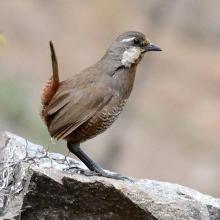Pteroptochos megapodius
Common name:
Moustached turca
Genus:
Pteroptochos
Family:
Rhinocryptidae
Suborder:
-n/a-
Pteroptochos megapodius
Common name:
Moustached turca
Genus:
Pteroptochos
Family:
Rhinocryptidae
Suborder:
-n/a-
Pteroptochos megapodius
Common name:
Moustached turca
Genus:
Pteroptochos
Family:
Rhinocryptidae
Suborder:
-n/a-
Family (Animalia): Rhinocryptidae
The tapaculos (pronounced /tæpəˈku:ləʊ/) are a family, Rhinocryptidae, of small suboscine passerine birds, found mainly in South America and with the highest diversity in the Andean regions. Three species (Chocó, Tacarcuna, and the silvery-fronted) are found in southern Central America.
Description
Tapaculos are small to medium-sized birds, with a total length ranging from 10–24 cm (4–9½ in). These are terrestrial species that fly only poorly on their short wings. They have strong legs, well-suited to their habitat of grassland or forest undergrowth. The tail is cocked and pointed towards the head, and the name tapaculo probably derives from Spanish for loincloth (literally "cover your behind" --because it ought to). Another possible explanation is that it originates from the Chilean name for the white-throated tapaculo, simply tapaculo, which is an onomatopoeic reference to its commonly heard song.
While the majority of the family are small blackish or brown birds there are some larger and more colorful species. All tapaculos are skulking birds that frequently stay low in dense vegetation, even the larger, colorful species, and this renders them difficult to see. They are best located and – in the case of Scytalopus spp. – identified by their vocalizations.
They feed on insects, seeds and other soft plant material with their pointed bills, and will scratch on the ground like a pheasant.
Most species lay two or three white eggs in a covered location, whether it be a burrow, a hole in a tree, or a domed nest.
Status and conservation
Some species have highly localized distributions and, being poor fliers, they easily become isolated in small populations. BirdLife International currently (2007) consider one species vulnerable (Scytalopus panamensis), three species endangered (S. iraiensis, S. rodriguezi and S. robbinsi), and two species critically endangered (Eleoscytalopus psychopompus and Merulaxis stresemanni). The two critically endangered species are restricted to Atlantic forest of eastern Brazil, and were only recently rediscovered after several years without any records.
Systematics
The tapaculos were traditionally placed in a distinct family Rhinocryptidae; more recent research (Irestedt et al. 2002, Rice 2005a,b) indicates that according to analysis of mt and nDNA sequence data, the tapaculos might be better merged into the Formicariidae as tribe Rhinocryptini, as they are closer to the antthrushes than either is to the true antpittas.
Alternatively, the latter might be raised to family status. In this case, it would be possible to maintain the tapaculos as a separate family too, but it would seem altogether more warranted to consider them a subfamily of the Formicariinae sensu stricto, which would be called Rhinocryptinae.
Whether this latter approach, the placement as a tribe in a tapaculo-antthrush Formicariinae subfamily, or maintenance as a separate family is to be preferred depends on whether the true antpittas are closer to the tapaculos and true antbirds, or rather to the Pittasoma "gnatthrushes" and other gnateaters and the true antbirds. There are some, albeit very tentative, indications that the latter may indeed be the case, which would be reflected in the placement of the tapaculos as subfamily Rhinocryptinae, with the Formicariinae being restricted to the true antthrushes (Rice 2005a). Today, the tapaculos continue in the Rhinocryptidae until the systematics can be further defined.
Apparently not all tapaculo genera would have to be moved to the formicariids (Irestedt et al. 2002). As the type genus Rhinocrypta certainly would, any distinct genera (such as the peculiar crescent-chests) would need a new family name.
An alternative family name Pteroptochidae, has been used historically.
Reference: Wikipedia

